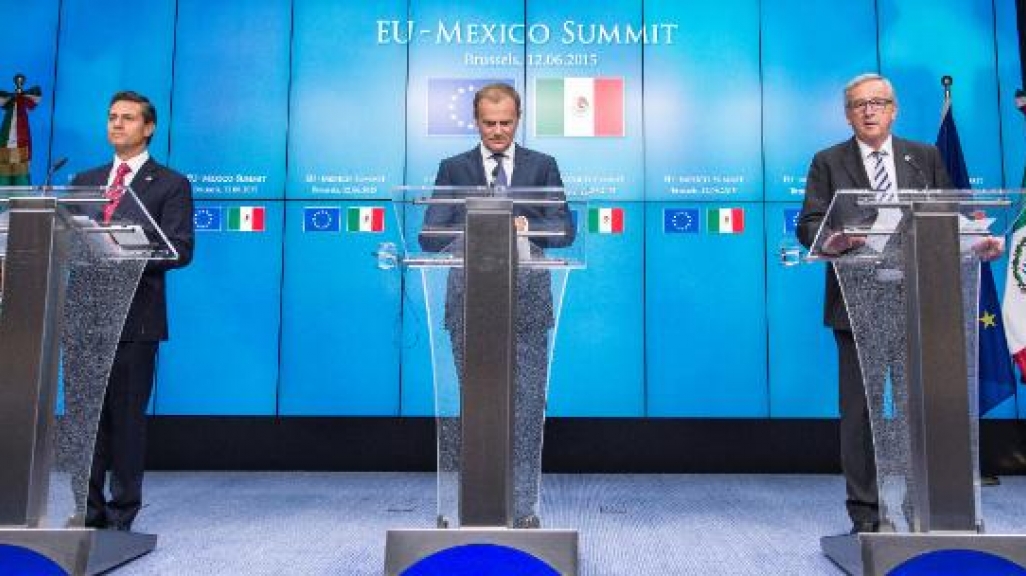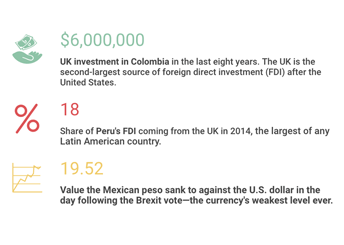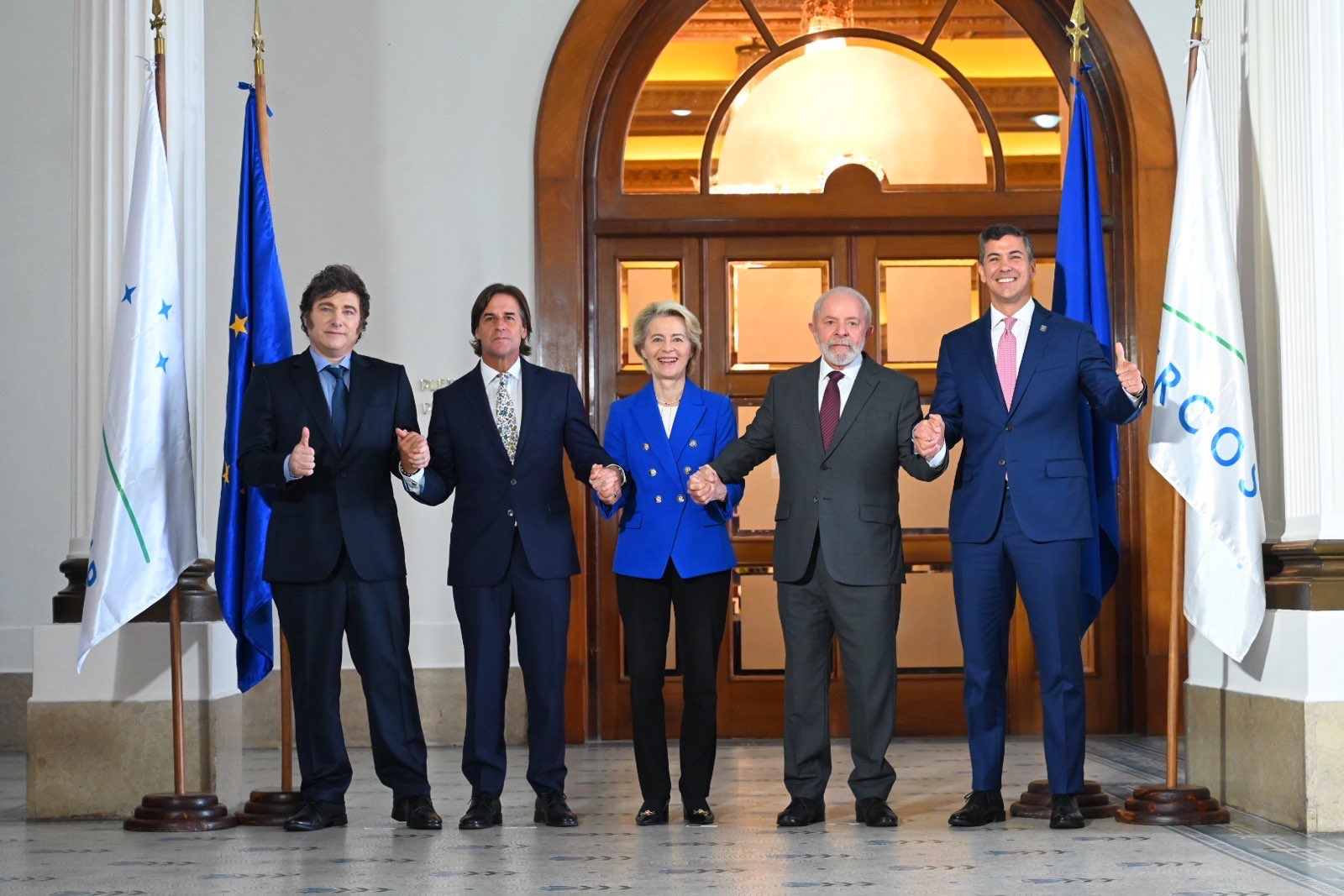Explainer: Trade between Latin America and the European Union
Explainer: Trade between Latin America and the European Union
The two regions trade more than $230 billion each year—a figure that could go up if the United States takes a protectionist turn.
In early February 2017, citing a “worrying rise of protectionism” in the wake of the inauguration of U.S. President Donald Trump, Mexico’s Economy Secretary Ildefonso Guajardo and EU Trade Commissioner Cecilia Malmström announced they were accelerating talks to modernize their existing trade agreement, with new rounds scheduled for early April and late June of this year.
The United States stepping back from global trade could also provide Latin American countries with the impetus needed to shore up their trade with the European Union, including a long-delayed free trade agreement between the European group and South America’s Mercosur bloc. That said, a more reasonable goal for EU trade levels with Latin America in the near-term might be to simply catch up—and keep pace—with China.
The EU was Latin America and the Caribbean’s third largest trade partner with more than $235 billion in bilateral trade in 2016. By comparison, in 2015 Latin America did $241 billion in trade with China and $689 billion with the United States.
Two-thirds of the goods the EU imports from Latin America are primary resources, including vegetable and mineral products, food, and tobacco that together were worth about $70 billion in 2014. Meanwhile, 87 percent of EU exports across the Atlantic are manufactured goods (chemicals, machinery, and vehicles, etc.), collectively worth roughly $107 billion that same year. Within the European Union, Germany and Spain are the top exporters to the region, responsible for over 40 percent of all EU exports to Latin America, while the Netherlands is the top importer, accounting for 18 percent of EU imports. On the other side, Brazil and Mexico represent more than half of all trade the region does with the European bloc.
The European Union has agreements or is in negotiations with the region’s countries through three types of arrangements: via trade blocs (Mercosur and Cariforum), multiparty regional agreements (Central American and Andean countries), and free-trade agreements (FTAs) with individual countries (Chile and Mexico). If and when the EU can finalize the FTA with Mercosur, it will have agreements with all countries in Latin America and the Caribbean, with the exception of Bolivia, Cuba, and Venezuela. Below, we take a look at the scope of those agreements, in order of trade volume.
Mercosur
$90 billion trade in goods in 2016
The European Union is Mercosur’s main trade partner and foreign investor, accounting for 21 percent of Mercosur’s total trade in 2015. Additionally, EU investment in Mercosur more than tripled in a span of 14 years, going from $141 billion in 2000 to $494 billion in 2014. The South American bloc’s main exports to the European Union in 2015 were agricultural products (24%), vegetable products such as soy and coffee (18%), and animal products including meats (6%), while EU exports to Mercosur included machinery (29%), chemicals and pharmaceuticals (24%), and vehicles and parts (17%).
But a trade agreement between the two has yet to come to fruition, despite almost two decades of trade talks. Negotiations first took place between 1999 and 2004, then again from 2010 to 2012 before restarting a third time in 2016, with meetings in May and October. In late November, then-Foreign Relations Minister of Brazil José Serra said that the uncertainty fueled globally by both Brexit and Donald Trump’s U.S. electoral victory could help propel the long-delayed agreement to the finish line. On March 6 of this year, meetings started up again in Madrid.
At the moment, the EU is just negotiating with the four founding members of Mercosur—Argentina, Brazil, Paraguay, and Uruguay—as Venezuela, which became a member in 2012, was suspended in December 2016, and Bolivia has yet become a full member. One of the main obstacles to an agreement is the reluctance of some EU member states like France, Ireland, and Poland to include in the agreement agricultural products from Latin America that would compete with domestically produced goods. France heads the opposition, stating that the EU has not calculated the effects that these imports could have on local European farmers and the environment.
Mexico
$57 billion trade in goods in 2016
Mexico became the first country in Latin America to sign a trade agreement with the EU in 1997, and the deal came into force in 2000. The two sides initiated the current modernization process to the agreement in 2016.
Mexico differs from most of the region in that it exports manufactured goods, as opposed to the agricultural and natural resources, to the EU. In 2016, 68 percent of EU imports from Mexico were manufactured goods, notably machinery and transport equipment. Such goods also represent 90 percent of EU's exports to Mexico. The main exports also include machinery and transport equipment, followed by chemicals and related products.
In addition to trade in goods, the two did $15 billion worth of trade in services in 2016.
The Andes
$27 billion trade in goods in 2016
The European Union signed a trade agreement with Colombia and Peru in 2012, and in 2016 Ecuador joined the deal. Bolivia, which is part of the Andean Community, has the option to join this agreement, though it could also do so via Mercosur if and when its ascension to that bloc is complete. Total EU trade with the Andean Community in 2016 totaled $12 billion in exports and $15 billion in imports. The main products exported from the Andes are agricultural products, fuels, and mining products, while the main imports from Europe are manufactured goods like machinery, transport equipment, and chemical products.
Before the June 2016 Brexit vote, Colombian President Juan Manuel Santos stated it would be a “headache” to hammer out agreements separately with the United Kingdom after having worked with the European Union. But, while on a trip in November to London and Belfast he promoted the idea of an agreement between the United Kingdom and another trade bloc: the Pacific Alliance, of which Colombia is a member along with Chile, Mexico, and Peru. During that same visit, Santos and UK Prime Minister Theresa May announced a new oil and gas partnership between the two countries, whose bilateral trade hit $1.7 billion in 2014.
Chile
$17 billion trade in goods in 2016
On March 6, Chile and the European Union inked a deal to facilitate trade on organic food products, an agreement Europe hopes will be the first of many in a “new generation” of such agreements with various Latin American countries. Food products and live animals make up a quarter of Chile’s exports to the EU, the third biggest export category after raw materials (28%) like copper, and manufactured goods (26%). The main EU exports to Chile are machinery and transport (52%), chemical products (15%), and manufactured goods (13%).
The recent organic foods agreement builds on trade ties between Brussels and Santiago that go back to 2003. The two are in the process of modernizing the commercial part of the agreement—including issues like tariff liberalization, customs cooperation, and sanitary measures—with negotiations set to take place in the second half of 2017.
Chile and the European Union also added another $6 billion trade in services to their bilateral total for 2016.
Central America
$11.4 billion trade in goods in 2016
Six Central American countries—Costa Rica, El Salvador, Guatemala, Honduras, Nicaragua, and Panama—signed an agreement with the European Union in 2012. Main Central American exports to the European Union are data-processing machines, coffee, bananas, and pineapple, and the main EU exports to Central America are machinery and mechanical appliances, electrical appliances, pharmaceuticals, motor vehicles, and steel.
The Caribbean
$11.3 billion trade in goods in 2016
The European Union and 15 Caribbean nations in the Cariforum group have had an economic partnership agreement in place since 2008. The accord provides not just for economic terms but also for substantial EU aid along with comprehensive labor rights and sustainable development measures.
The European Union is the second-largest trading partner for the Cariforum nations after the United States. The main exports from the Caribbean to the European Union include bananas, sugar, minerals, fuel, and mining products, and the main imports from going the other way include cars, boats, ships, and phone equipment.
Chart by Holly K. Sonneland.









